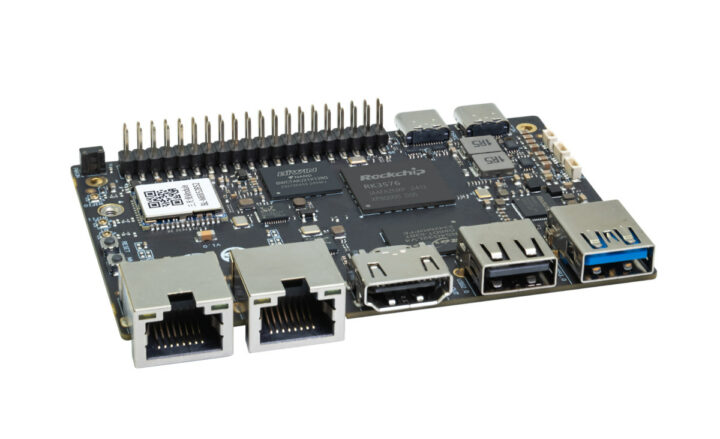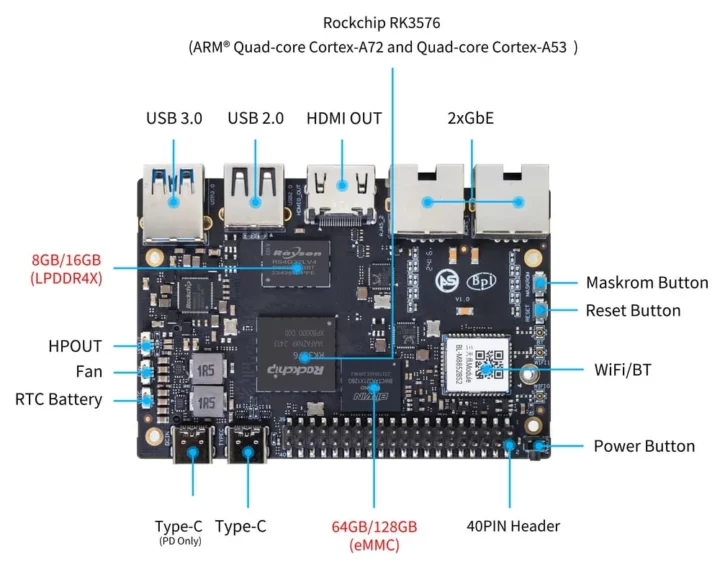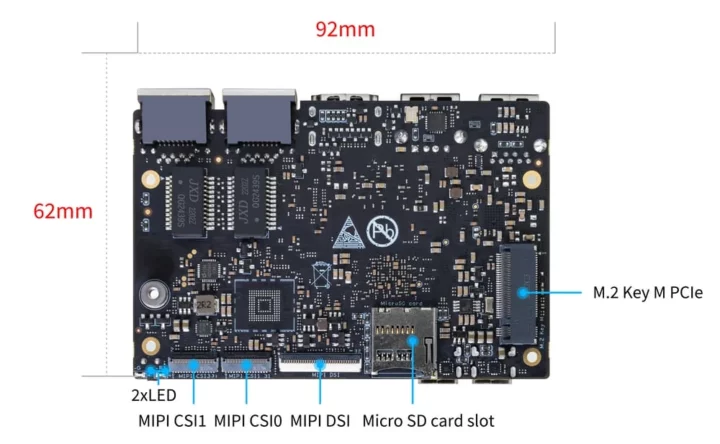Banana Pi BPI-M5 Pro, also known as Armsom Sige5, is a low-profile single board computer (SBC) powered by the Rockchip RK3576 octa-core Cortex-A72/A53 SoC for the AIoT market that offers a mid-range offering between Rockchip RK3588 and RK3399 SoCs.
The board comes with 16GB LPDDR4X and 128GB eMMC flash by default, offers dual GbE, WiFi 6 and Bluetooth 5.2 connectivity, an M.2 2280 PCIe socket for expansion, HDMI and MIPI DSI display interfaces, two MIPI CSI camera interfaces, a few USB ports, and a 40-pin GPIO header.
Banana Pi BPI-M5 Pro specifications:
- SoC – Rockchip RK3576
- CPU
- 4x Cortex-A72 cores @ 2.2GHz, four Cortex-A53 cores @ 1.8GHz
- Arm Cortex-M0 MCU at 400MHz
- GPU – ARM Mali-G52 MC3 GPU with support for OpenGL ES 1.1, 2.0, and 3.2, OpenCL up to 2.0, and Vulkan 1.1
- NPU – 6 TOPS (INT8) AI accelerator with support for INT4/INT8/INT16/BF16/TF32 mixed operations.
- VPU
- Video Decoder: H.264, H.265, VP9, AV1, and AVS2 up to 8K @ 30fps or 4K @ 120fps.
- Video Encoder: H.264 and H.265 up to 4K @ 60fps, (M)JPEG encoder/decoder up to 4K @ 60fps.
- CPU
- System Memory – 8GB or 16GB 32-bit LPDDR4x
- Storage
- 32GB or 128GB eMMC flash
- MicroSD card slot
- M.2 Key-M socket for M.2 2280 NVMe SSD (See Expansion section)
- Footprint for UFS storage, but apparently unused
- Video Output
- HDMI 2.0 port up to 4Kp120
- MIPI DSI connector up to 2Kp60
- DisplayPort 1.4 via USB-C up to 4Kp120
- Audio – Speaker header, digital audio output via HDMI
- Camera I/F – 2x 2-lane MIPI CSI connectors
- Networking
- 2x Gigabit Ethernet ports
- WiFi 6 and Bluetooth 5.2 via Realtek RTL8852BS
- USB – 1x USB 3.0 port, 1x USB 2.0 port, 1x USB Type-C port
- Expansion
- 40-pin GPIO header
- M.2 Key-M socket (PCIe 2.1 x1)
- Misc
- MaskROM button, Reset button, Power button
- Fan connector
- RTC battery connector
- 2x LED
- Power Supply – 4.5V to 23V via USB Type-C PD port
- Dimensions: 92 x 62mm (8-layer PCB)
- Weight – 43 grams
- Temperature Range – 0°C to 80°C
The Banana Pi BPi-MP5 Pro supports Android 14 and Debian 12 images, Buildroot is supported through official Rockchip support, and third-party Armbian Ubuntu and Debian images may become available soon. Documentation is available on both Banana Pi and ArmSom websites with the latter providing links to the Android 14 and Debian 12 images.
Banana Pi previously released the BPI-M5 SBC with an Amlogic S905X3 SoC, so you’d assume the Pro version would have many features in common, but the two boards have completely different designs…
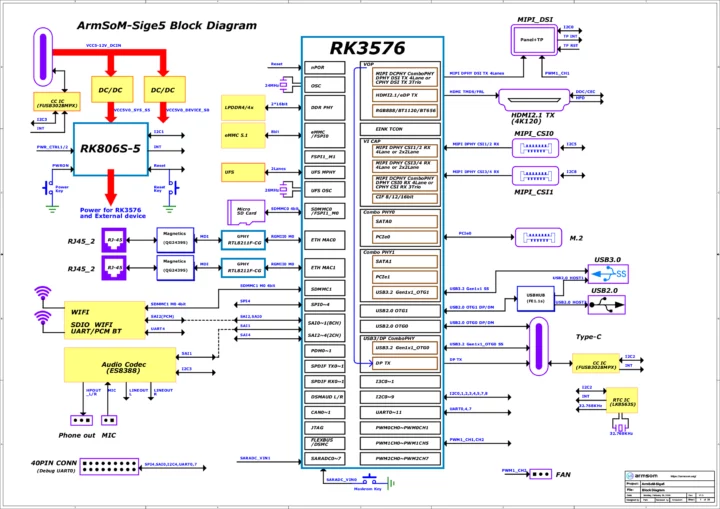
The Banana Pi BPI-M5 Pro is for sale on SinoVoIP’s Aliexpress store for $131.58 (8GB LPDDR4/64GB eMMC configuration) unless you also need an enclosure with antennas in which case the price is $146.31. Alternatively, the ArmSom Sige5 Pro is sold for $124 plus shipping on the company’s website. It does not seem particularly good value as the Orange Pi 5 Pro which similar features (but only one GbE port) and a more powerful Rockchip RK3588S processor goes for $96.99 on Amazon in the same 8GB RAM configuration and a 64GB eMMC flash module adds just $18.99. Maybe it is still worth it for use cases where the low-profile design may be important.
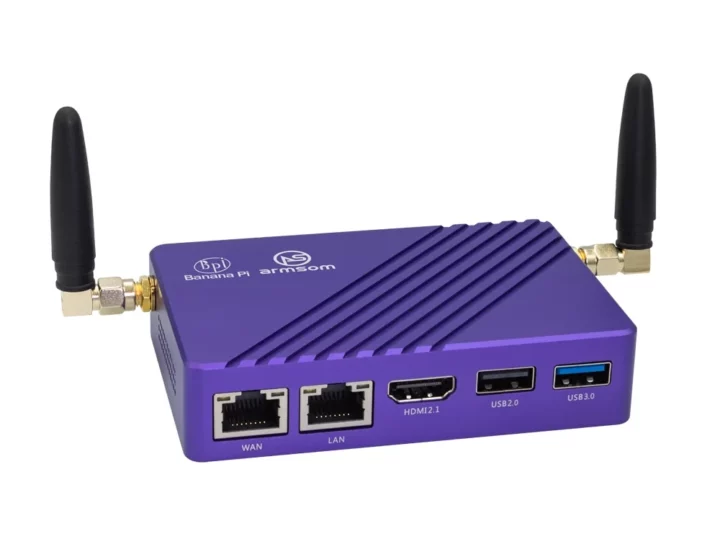
Updated: This post was initially published on May 2, 2024, and updated following availability on Aliexpress and the launch of the enclosure.

Jean-Luc started CNX Software in 2010 as a part-time endeavor, before quitting his job as a software engineering manager, and starting to write daily news, and reviews full time later in 2011.
Support CNX Software! Donate via cryptocurrencies, become a Patron on Patreon, or purchase goods on Amazon or Aliexpress


